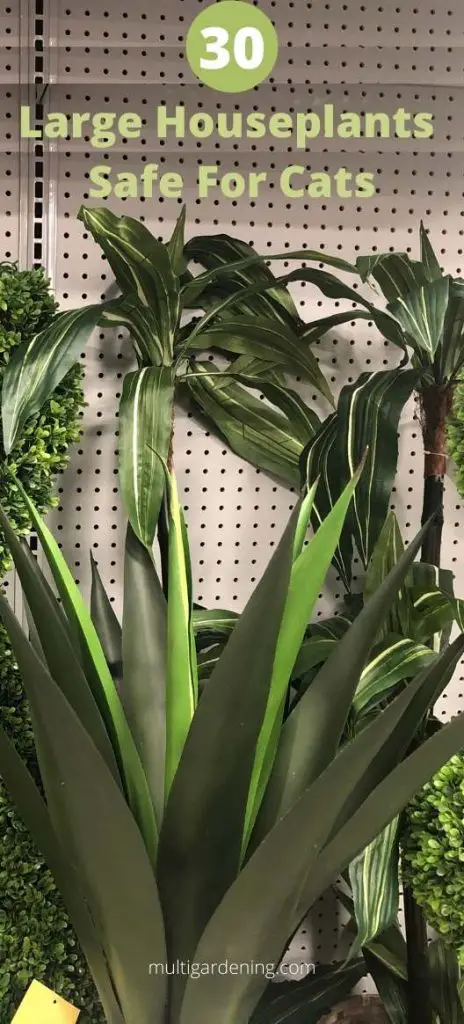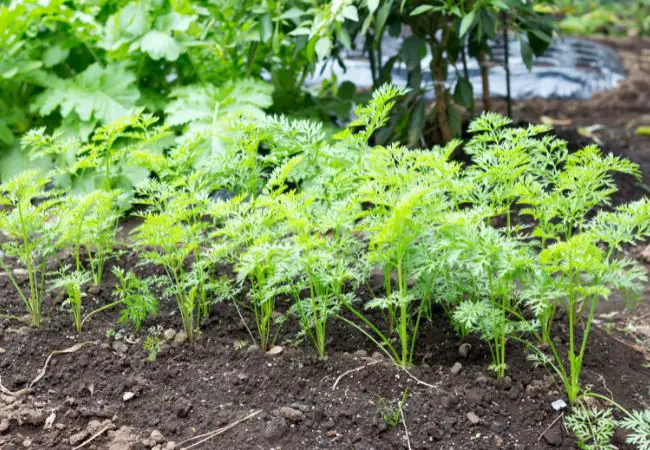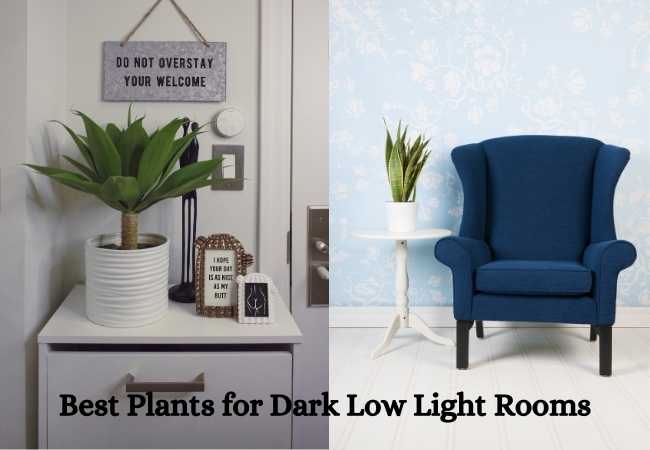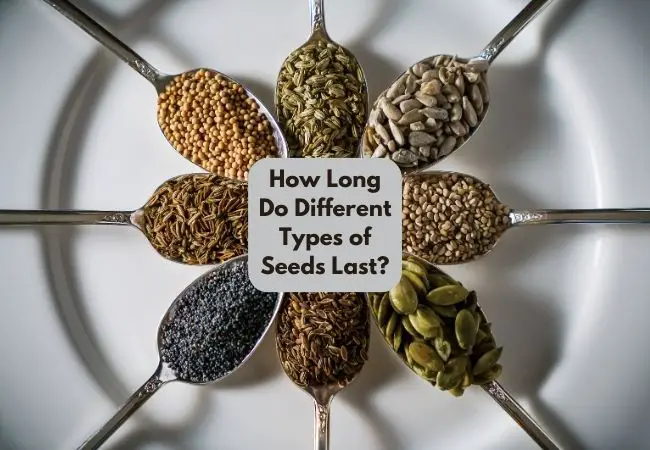30 Large Houseplants That Are Safe For Cats

Large houseplants that are safe for cats and will coexist peacefully. The following is a list of plants that are considered to be safe for cats. This list contains plants that also have the potential to grow large.
Large Houseplants Safe For Cats
One of the challenges that most cat and plant owners face is the worry that your plants will poison your pet cat. If you have a cat, and also love plants you might be wondering which plants will grow large. Here is a list of some of the plants I have seen grow large and are also safe for cats.
Areca Palms
Scientifically known as Dypsis lutescens. These palms are not only good for cat owners since the areca palm is non-toxic to pets, but they are also considered to be air-purifying houseplants.
Asparagus Ferns
Asparagus ferns not only look good in the home, but they benefit cats by absorbing benzene and trichloroethylene from the air. These chemicals can cause cancer in humans and may also be harmful to cats.
Boston Ferns
Scientifically known as Nephrolepis exaltata bostoniensis. These ferns are great at removing chemicals such as formaldehyde from the air, which can irritate a cat’s eyes, nose, and throat.
Boston ferns are also some of the easiest ferns to grow both indoor and outdoor.
English Ivy Plants
Scientifically known as Hedera helix. This evergreen vine is safe for cats and also makes a good ground cover option in the home. It provides an excellent hiding place for pet cats, which helps them to feel more comfortable.
English ivy is not only great at absorbing toxins, but it’s also very easy to maintain. Just be sure that you keep your cat away from any loose vines or leaves because they could wrap around the pet’s body and cause discomfort.
Ficus benjamina Plants
Scientifically known as Ficus benjamina and commonly referred to as the Weeping Fig Tree. These plants are not only good at removing chemical toxins from the air, but they are also very easy to care for. Like the rubber plant, weeping fig trees are great at removing benzene and trichloroethylene from the air.
If you have an indoor cat, this is definitely a plant he or she will enjoy having around. They also provide an area for cats to hide, making them feel more like part of the family.
Maidenhair Ferns
Scientifically known as Adiantum hispidulum maidenhair fern. These plants are not only beautiful, but they are also completely safe for cats if they attempt to eat them.
In fact, some veterinarians actually recommend this as a safe houseplant for cats who may have the tendency to eat plants. Ferns are also easy to grow in pots and containers around the house.
Pothos Plants
Scientifically known as Epipremnum aureum. These plants are great for absorbing formaldehyde from the air and also help to remove benzene, which is another chemical that could be dangerous for your cat.
Pothos are common houseplants that you can get easily in local nurseries as well as online. My favorite is the Golden Pothos.
Aloe Plants
The gel inside of an aloe plant is helpful in treating wounds and can also be used to soothe a cat’s digestive and urinary tracts. Aloe vera plants are easy to care for even for beginners. They also last long and when provided with the proper care will grow large.
Ficus elastica Variegate
Scientifically known as Ficus elastica variegate. The variegate type has bicolored leaves while the none variegated one has green leaves. These houseplants are great at not only removing benzene and trichloroethylene from the air, but they provide a hiding place for cats as well.
Rubber plants have very beautiful leaves and make very beautiful indoor houseplants. Most people keep them for their leaves and are not even concerned about flowers.
Schefflera arboricola Houseplants
Scientifically referred to as Schefflera arboricola. Schefflera houseplants are great at absorbing chemical toxins in the home, including benzene. Your cat will also enjoy having this plant around since it gives him or her a place to hide and feel safe. Check out this post on how to grow schefflera and the complete care guide.
Ponytail Palm
This palm is scientifically known as Beaucarnea recurvata. These plants not only look good in the home but they help clean the air by removing formaldehyde.
They are also very resilient and can stand up to most cats accidentally knocking them over without sustaining any damage.
Peace Lily
Peace Lilies are known as Spathiphyllum. The peace lily is not only an excellent plant for eliminating toxins from the home, they are also completely safe if your cat decides to eat one.
Peace lilies are beautiful plants that you can keep in any room in the house and use for decoration.
Ficus Robusta Rubber Tree Houseplants
Ficus robusta is the scientific name of this type of rubber plant. As is the case with most types of rubber trees, these plants are great at removing benzene and trichloroethylene from the air and provide a nice space for your cat to play or hide.
ZZ Plant
ZZ Plants are scientifically known as Zamioculcas zamiifolia. ZZ plants are very resistant to most pests and diseases, including cats. They also have a striking appearance that will really liven up your home.
If you want your ZZ plant to grow large, don’t subdivide it. When it outgrows the current pot, repot it into a bigger pot without subdividing.
Spider Plant
Spider plant is also known scientifically as Chlorophytum comosum. Spider plants are great for absorbing formaldehyde and other chemicals from the air in your home, including benzene. They’re also pretty hardy and easy to care for.
Jade Plant Houseplants
Jade plants are scientifically known as Crassula ovata. Jade plants are great for absorbing formaldehyde from the air, so they’re an excellent choice if you have a cat at home. They also help reduce carbon monoxide in your home, which can be harmful to your pet’s health.
Ficus elastic Rubber Plant Houseplants
Scientifically know as Ficus elastica or commonly as rubber plants. This is the most common type of rubber plant. It has plain green leaves compared to the variegated type that has bi-colored leaves.
As is the case with most types of rubber trees, these plants are great at removing benzene and trichloroethylene from the air and provide a nice space for your cat to play or hide.
Bamboo Palm Tree
The bamboo palm tree is also known as Chamaedorea seifrizii. The bamboo palm tree is an excellent plant to have in your home if you have a cat. It’s very easy to maintain and provides a place for your pet to play or hide.
The palm is not fussy and will grow very large and thrive if the owner gives it all the necessary requirements.
Snake Plant Houseplants
Snake plants are also scientifically known as Sansevieria trifasciata. There are also other types of Sansevieria that interested plant owners can check out.
Snake plants are great at absorbing toxins like formaldehyde and benzene from the air. They’re also very easy to care for, making them one of the best houseplants for pet owners.
Large Houseplants Safe For Pet Cats
It is always a pleasure seeing your houseplants grow large and flourish. If you have a cat, this might be hindered by the cat knocking them over or chewing on them.
I hope this post on large houseplants that are safe for cats gave you some ideas on some of the cat-safe plants that you can grow in your home. Please share it and also follow me on Multigardening Pinterest for more on houseplants.






